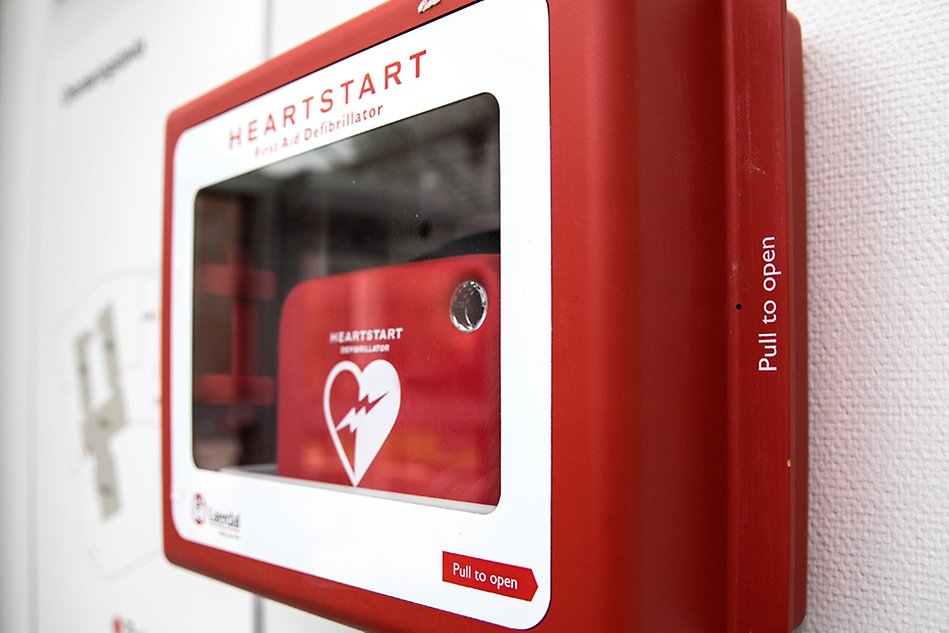Defibrillators
Halmstad University should be a heart safe workplace, therefore we have four defibrillators on Campus. No specific training is needed since the defibrillator is self-instructing, although in Swedish.
Our defibrillators are positioned so that you are always close to one on campus. You do not need any specific training as the defibrilator is self-instructional. It fits in a small and flexible bag and is designed to be easy to understand, to reduce the risk of mistakes when handling. A voice in Swedish explains how the device is used.
Defibrillators on Campus
- next to the spiral staircase in building E between the ground floor and second floor
- in the glass aisle opposite restaurant Mangold
- in the corridor between the R and S buildings, on the ground floor
- on the ground floor in building I (University Hall)
- in the main entrance of building S

Students are trained every year
Even if no training is necessary to handle a defibrillator, it's a good idea to take a course in CPR. Around 450 people at the University have CPR skills. Every year, 20–30 nursing students and another 60 students who are involved in Fresher's Week are trained.
Chain of survival – five key factors
The key factor when cardiac arrest occurs is time – how fast a person receives care.
- Early alarm to healthcare (112)
- Early cardiopulmonary resuscitation (CPR)
- Early defibrillation (use of defibrillator)
- Early and advanced care outside hospital
- Advanced care after resuscitation
Questions and answers about difibrillators
What is a defibrillator?
There are different types of defibrillators. The one used at the University is an Automatic External Defibrillator (AED), which is suitable for use by people without medical training. The device has electrodes which are attached to the victim's chest and the machine then analyses the person's heart rhythm. If the person's heart rhythm is not normal, an electric shock is administered to restart the heart.
Who is allowed to use a defibrillator?
Anyone can use a defibrillator and there is no law that requires you to have medical training to be allowed to use it. However, it is recommended to take a course in CPR and to repeat regularly.
How do I know I am doing it right?
The defibrillators at the University are self instructing and speak Swedish. Follow the instructions for the defibrillator and regularly attend a CPR course to keep your skills up-to-date.
Can you injure someone using a defibrillator?
Built-in functions in the machine prevent injuring someone. The machine only administers an electric shock at determined signals that are only present during cardiac arrest. However, there are some rules that are to be followed, such as not touching the victim when an electric shock is to be administered.
How do I know it is caridiac arrest? How do I know when to stop using the defibrillator?
During a cardiac arrest, the person quickly becomes unconscious and shows no signs of life. When you have placed the electrode on the person, the machine will analyse him/her and determine whether defibrillation is needed or not. It will also indicate if more shocks are needed, depending on whether the heart has resumed its normal rhythm or not.
How will I know if the defibrillator is ready to use?
The defibrillator performs a daily self test. As long as the green Ready light is blinking, no testing of the defibrillator is necessary. Regular checks are done by replacing used or out-of-date consumables every other or every fifth year. The defibrillator is also checked during workplace safety rounds. If you discover that the machine is missing or seems damaged in some way, please contact the University HR Department.
Who gets cardiac arrest?
Sudden cardiac arrest can happen to anyone. It could be a family member, a colleague, a person on the street or a close friend, young as well as old.
How many are afflicted by cardiac arrest in Sweden? How many survive?
Every year, around 10,000 people in Sweden are afflicted with sudden cardiac arrest and treatment is started on around 4,000. Of these, only around 400 survive. That means the majority dies.
Where can a defibrillator be useful?
Since cardiac arrest happens in all age groups and often without warning, it is impossible to define exact locations for where each defibrillator should be placed. Locations where there are a lot of people or where many people pass by as well as high risk locations such as sports facilities, public baths and similar places are suitable locations for the placement of defibrillators.

